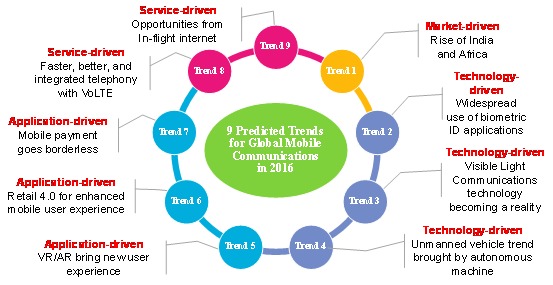With the continuing evolution of mobile communications industry brought about by several innovative technologies such as B4G, IoT and cloud, MIC - the government-backed IT research institute headquartered in Taiwan - released its 9 predicted trends for 2016 that the institute believes will play a key role in rejuvenating mobile communications development worldwide at its annual Forum held in Taipei between September 11 and 24.
9 Predicted Trends for 2016 Global Mobile Communications

Source: MIC, September 2015
Trend 1: Rise of India and Africa
With the global smartphone industry showing a noticeable slowdown and the nearly saturated mobile phone demand in China, the next areas of focus have been increasingly leaning towards India and Africa, where smartphone penetration is still relatively low and population base is relatively huge. This is evidenced by the fact the combined share of India and Africa has been increasing rapidly since 2014 and is anticipated to seize over 20% of global smartphone market by 2018. What is most important is that India's native brands accounted for over 40% of total smartphones sold in India in the first half of 2015, up from merely 1% in 2011.
Trend 2: Widespread Use of Biometric ID Applications
Under the IoT trend, information has been digitalized and shifted to cloud-end. Importance of personal data security and safety is rising rapidly as hacker technology evolves fast and traditional encryption technology is unable to provide full protection. Biometric ID technology has become widespread, for instance, NTT DoCoMo's iris scan phone that embraces Snapdragon Sense ID processor. Hence, MIC anticipates that global shipment volume of fingerprint ID chips will reach 400 million in 2015 and further increase to 600 million in 2016, with over 40% penetration rate.
Trend 3: Visible Light Communications Technology Becoming a Reality
With the lighting technology leapfrogging, VLC (Visible Light Communications) technologies have succeeded in transmitting data. That is, LED not only can provide lighting but also can communicate. Where there is light, people can communicate. This has significantly improved the value of VLC applications as it allows various internet scenarios for people who are on airplane, in hospital and underwater.
Trend 4: the Rise of Autonomous Machine
The unmanned trend brought by autonomous machines have been able to integrate a wide range of technologies with regards to sensors, autonomous viewing and communications, artificial intelligence and smart control to optimize machines to perform more efficiently than mans. Over the years, several automakers/IT brands have plans to commercialize their unmanned vehicles such as Google and Audi (2017), Tesla Motors (2019), GM (2020), Mercedes (2020), BMW (2020) and Renault (2020) and Ford (2025) in anticipation of rising tide of autonomous machines.
Trend 5: Virtual Reality/ Augmented Reality in Vertical Markets
Thanks to the improved resolution and stability, virtual technologies like VR and AR are also growing in maturity to covering more applications. Increasing importance of VR and AR has spiked interest of ICT brands like Samsung, Google, Facebook, Microsoft, and Nokia and they have begun to invest AR/VR-related CPE and applications to target vertical market sectors of multimedia, gaming, medical, educational and advertising.
Trend 6: Retail 4.0 to Enhance Mobile Shopping Experience
Retail 4.0 provides apps on mobile devices such as IPS (Indoor Positioning System) and O2O transactions for better mobile shopping experience. Leveraging Retail 4.0 enables retailers to collect big data from mobile devices to help them undertake precision marketing while slashing labor costs by cutting staff. Meanwhile, consumers are able to obtain real-time information from LBS for real-time decisions.
Trend 7: Mobile Payment Goes Borderless
As bans on mobile payments are lifted, mobile users now can make mobile payments that break the boundary of countries (e.g. Taiwan's EasyCard may be interoperable with Singapore's EZ-Link and Hong Kong's Octopus Card), networks (e.g. several vendors have been optimizing their online and mobile payment processes), accounts (e.g. third-party payment mechanism), and online/offline platforms (e.g. Chinese consumers are able to pay anything purchased in Taiwan using legitimate app to scan the QR code such as Alipay)
Trend 8: Faster, Better and Integrated Multimedia Services with VoLTE
As of July 31, 2015, there are already 25 operators commercializing their own VoLTE (Voice Over LTE) services while an additional of 103 operators have devoted into VoLTE research and testing. For example, some operators like Korean SKT and LGU+ have planned to apply VoLTE to smart home and IoT sectors. In the future, the VoLTE coverage will include medical, public safety (such as the deployment of Firstnet in the US) and retail sectors.
Trend 9: In-Flight Internet Service Opportunities
To date, there are about 50 airlines that provide in-flight internet services. They all reckon this area will promise them future opportunities, as nearly 70% of consumers take Wi-Fi service into consideration when choosing airline. According to EuroConsult, the number of internet connected airplanes is predicted to grow 5-fold by 2023, up from 3,000 in 2013. Several vendors have been dedicated to developing in-flight internet technologies that boast wider bandwidth and cross-border services, such as Gogo, Row 44, Panasonic, OnAir, ViaSat, and Inmarsat, just to name a few.
For future receipt of press releases, or more information about MIC research findings, please contact MIC Public Relations.
About MIC
Market Intelligence & Consulting Institute (MIC), based in Taipei, Taiwan, was founded in 1987. MIC is Taiwan's premier IT industry research and consulting firm providing intelligence, in-depth analysis, and strategic consulting services on global IT product and technology trends, focusing on markets and industries in Asia-Pacific. MIC is part of the Institute for Information Industry. https://mic.iii.org.tw/english